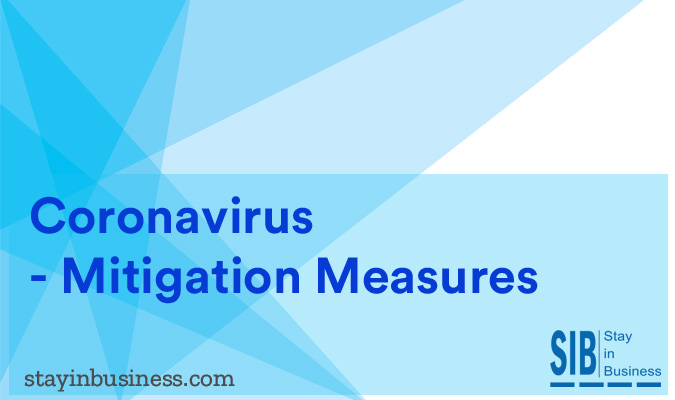Coronavirus Mitigation Measures

Coronavirus refers to a group of viruses frequently found in humans and other animals such as camels, cattle, cats and bats. Animals rarely pass on the coronavirus to humans which can then spread to other human beings as was the case in MERS-CoV and SARS-CoV.
Recommended Actions
Strongly advise sick and unwell staff to remain at home.
- This applies especially to individuals suffering respiratory illnesses who should not enter office premises until all symptoms of fever have been ruled out (100.4° F [37.8° C] or more using an oral thermometer) for more than 24 hours without the use of medication such as cough suppressants
- Give employees flexible sick leave options that are in line with public health guidance. Keep employees informed of their options
- Vendors supplying contractual or temporary staff must enforce work from home and non-punitive leave options for sick employees
- Waive off mandatory medical certificate for personnel suffering from acute respiratory sickness to authenticate their illness or report back to work as they might not be able to obtain such documents on time owing to the high volume of cases that healthcare providers attend to
- Grant employees the flexibility to attend to their official duties from home while simultaneously attending to a sick relative. Staying indoors would be unavoidable in the case of individuals who need to care for children and old family members
Quarantine personnel who have contracted the virus.
- Personnel with visible signs of respiratory infections such as cough or breathing trouble, should be secluded from other employees at office. Arrangements should be made to send them home immediately. Those infected must always cough or sneeze into a handkerchief, tissue or their own elbow or shoulder.
Raise awareness among employees. - Infected employees must be strongly advised against going to office.
- Staff must be given sufficient training on respiratory etiquette and hand hygiene.
- Dos and don’ts must be publicized in the workplace through posters, hand-outs, email reminders etc.
- Keep adequate supplies of tissues and no-touch disposal receptacles for employee use.
- Ensure that employees use only (i) alcohol based sanitizers with 60 to 90 percent alcohol or (ii) soap and water if hands are unmistakably unclean.
Regularly clean the office space and surroundings.
- Regularly clean workstations, counter-tops, doorknobs and other frequently touched surfaces using appropriate cleaning surfaces.
- Use-and-throw cleaning material can be used to wipe frequently touched surfaces such as doorknobs, keyboards, remote controls, desks etc.
Provide detailed guidance & recommendations to employees before traveling.
- Employees must be given travel instructions specific to the country they are visiting
- Proper training must be imparted on detecting symptoms of acute respiratory illnesses
- Employees must follow clearly outlined protocols when they test positive, for instance, informing their supervisor, staying at home, consulting healthcare provider, avoiding contact with other employees etc.
- Protocols must be clearly distinguished for employees who test positive before traveling on an official trip, during an official trip and after returning from an official trip.
- Protocols must be clearly distinguished for employees traveling within and outside the country.
- Employees must be provided a list of recommended healthcare services, medications, vaccines.
Plans must adapt and stay updated depending on how the virus evolves over a period of time.
- Instruct employees on how to accurately assess the risk of exposure to coronavirus. This is crucial in the case of individuals whose family members or relatives at home have already contracted the virus.
- Risk assessments must also be conducted at the workplace, but discretely so as to avert discrimination against an infected employee.
Coronavirus Preparatory Measures in the USA
Enterpreneurs must stay prepared to seamlessly adapt business processes depending on the scale and intensity of a coronavirus outbreak’s impact on operations. The risk of exposure is less in non-healthcare sectors.
Planning for Coronavirus
Business leaders must prioritize mitigating the spread of coronavirus among employees in the event of an outbreak in their area. The company’s crisis time objectives can include but are not limited to (i) curtailing the transmission of the virus among staff (ii) providing additional protection to people who are more vulnerable (iii) ensuring business as usual (iv) curbing the virus’ impact on other components in the supply chain network. Keep the following factors in mind while developing a response plan:
- Precisely evaluate the intensity of outbreak at your workplace – number of people infected, receiving medical attention, fatalities and so on.
- Identify and provide special attention to employees who are vulnerable to the disease owing to age, medical conditions etc.
- Make arrangement to counter a higher incidence of employee absenteeism through remote or mobile access and other work from home options.
- Absenteeism should be closely followed with feasible workarounds to keep mission critical processes operational
- Cross-training across departments can drastically minimize the impact when key personnel aren’t available or not available in sufficient numbers
- Identify mission critical tasks, inter-dependencies – both internal and external – and other factors that can impact the delivery of your products, services and solutions.
- Maintain an updated and readily available list of alternate providers.
- Prioritize business processes. Mission critical tasks might require a 360 degree turnaround for business to transition the crisis.
- Tough decisions might be required such as temporarily stalling some operations.
- Businesses with multiple facilities in different locations should designate a deciding authority for each site who takes responsibility for preparatory, preventive, response and recovery measures, depending on local conditions.
- It is highly recommended to connect with the local region’s official agencies for access to timely and precise information that can make plans more relevant.
Categories: Health, Living, Natural Disasters, Safety, Supply Chain
